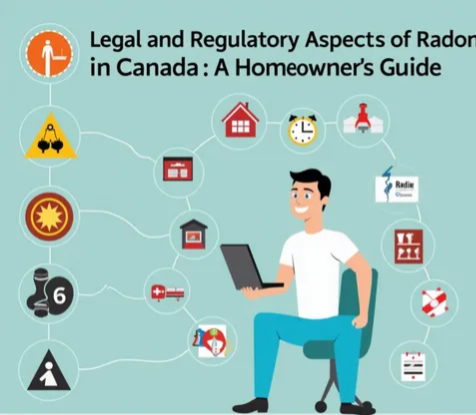Radon is a naturally occurring radioactive gas that can seep into homes and buildings through cracks in foundations and other openings. In Canada, it is a growing concern, with high radon levels detected in many regions. While radon is invisible, odorless, and tasteless, it poses significant health risks, especially lung cancer, if left unaddressed. This article will focus on the legal and regulatory aspects of radon in Canada to help homeowners understand their responsibilities, rights, and the steps they should take to ensure their homes are safe.
Understanding Radon and Its Impact in Canada
Radon comes from the natural breakdown of uranium in soil, rock, and water. In Canada, many regions, especially areas with high concentrations of granite, are at greater risk of elevated radon levels. The government has recognized the potential health risks posed by radon and has established specific guidelines and regulations to mitigate these risks.
Canada’s Radon Exposure Guidelines
In 2007, Health Canada set the national radon exposure guideline at 200 becquerels per cubic meter (Bq/m³). This level is based on the concentration of radon gas in indoor air. If radon levels exceed this threshold, homeowners are encouraged to take corrective actions. Here are key points of the guideline:
- 200 Bq/m³ Limit: Any indoor radon level above this should be addressed.
- Testing Recommended: Homeowners are encouraged to test for radon, especially in high-risk areas.
- Action Within Two Years: If radon levels exceed 200 Bq/m³, Health Canada advises homeowners to take action within two years, or sooner if levels are significantly higher.

Radon and Real Estate: What Homebuyers Should Know
While Canada doesn’t have a federal law requiring radon testing before the sale of a home, many provincial governments and real estate boards are increasingly recommending it as part of home inspections. Some real estate contracts may include clauses about radon testing, especially in high-risk areas. Homebuyers should be aware of:
- Radon Testing During Home Inspections: It is becoming common practice to request radon testing as part of the home inspection process.
- Disclosure: In some provinces, sellers may be required to disclose if their homes have tested for radon or undergone radon mitigation.
Provincial Regulations on Radon
While national guidelines are set by Health Canada, radon regulations vary by province. For example:
- Ontario: The province has no mandatory radon testing requirements, but Ontario’s Building Code includes provisions for radon mitigation in new homes.
- British Columbia: BC has identified radon-prone areas and encourages testing, with some local municipalities requiring radon-resistant construction methods.
- Manitoba and Saskatchewan: These provinces are among the highest risk areas for radon exposure, and building codes have been updated to include radon mitigation requirements for new constructions.
Employer and Workplace Radon Regulations
Workplaces in Canada are also required to adhere to specific radon safety regulations. According to the Canada Labour Code, employers must test and address high radon levels in workplaces. Key points include:
- Occupational Exposure Limits: Employers must ensure radon levels in workplaces are below 200 Bq/m³.
- Workplace Testing: Buildings with occupied basements or ground-level areas are recommended for radon testing.
- Mitigation Responsibilities: Employers must take corrective action to reduce radon exposure if levels exceed the recommended limit.


